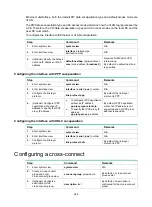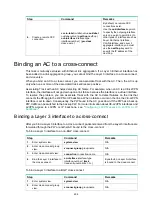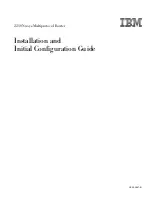
392
4.
Bind the AC to the PW:
Bind the Layer 3 physical interface or Layer 3 subinterface to the PW, so the PE forwards
packets between the AC and the PW.
Local connection establishment
To set up a local MPLS L2VPN connection between two CEs:
1.
Set up ACs:
Configure the link layer protocol to set up an AC between the PE and each CE. For more
information, see "
Set up an AC between a PE and a CE:
."
2.
Bind the two ACs:
Bind the PE's interfaces connected to the two CEs so the PE can forward packets between
CEs.
PW data encapsulation types
MPLS L2VPN transports Layer 2 data of different data link layer protocols through PWs. A PE
encapsulates a Layer 2 packet received from an AC according to the PW data encapsulation type.
The PW data encapsulation type is determined by the link type of the AC, as shown in
Table 38 Relationship between AC types and PW data encapsulation types
AC type
PW data encapsulation type
Ethernet
Ethernet
VLAN
PPP PPP
HDLC HDLC
Ethernet over MPLS
Ethernet over MPLS uses MPLS L2VPN to connect Ethernets, and delivers Ethernet packets
through a PW over the MPLS backbone.
The following PW data encapsulation types are available for Ethernet over MPLS:
•
Ethernet
—P-tag is not transferred on a PW.
{
For a packet from a CE:
−
If the packet contains a P-tag, the PE removes the P-tag, and adds a PW label and an
outer tag into the packet before forwarding it.
−
If the packet contains no P-tag, the PE directly adds a PW label and an outer tag into the
packet before forwarding it.
{
For a packet to a CE:
−
If the access mode is configured as VLAN by using the
ac
interface
command, the PE
adds a P-tag into the packet before sending it to the CE.
−
If the access mode is configured as Ethernet by using the
ac
interface
command, the
PE directly sends the packet to the CE.
You cannot rewrite or remove existing tags.
•
VLAN
—Packets transmitted over a PW must carry a P-tag.
{
For a packet from a CE:
−
If the peer PE does not require the ingress to rewrite the P-tag, the PE keeps the P-tag
unchanged for the packet, and then encapsulates the packet. If the packet contains no
















































